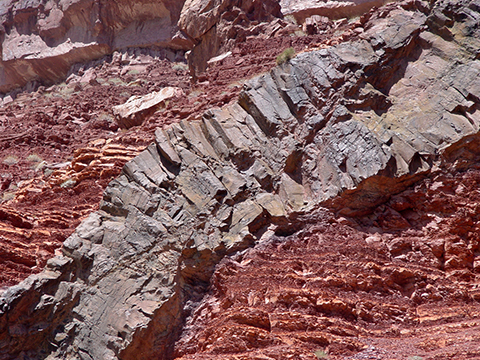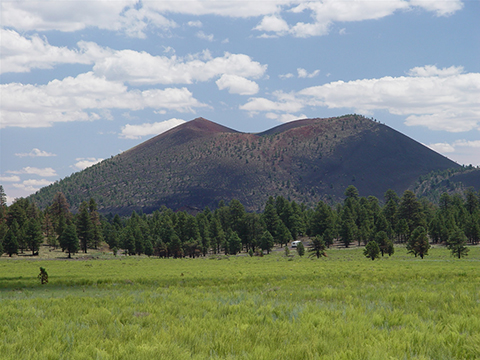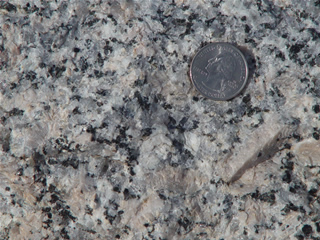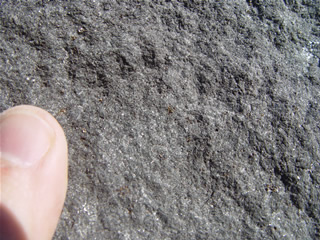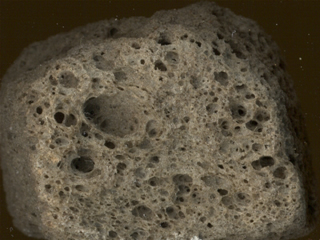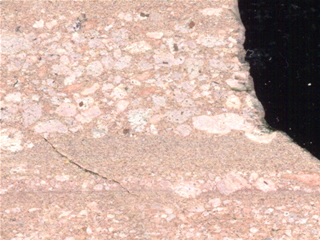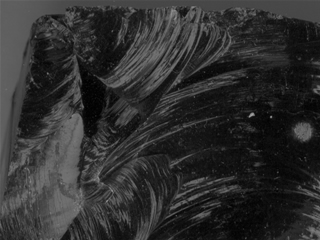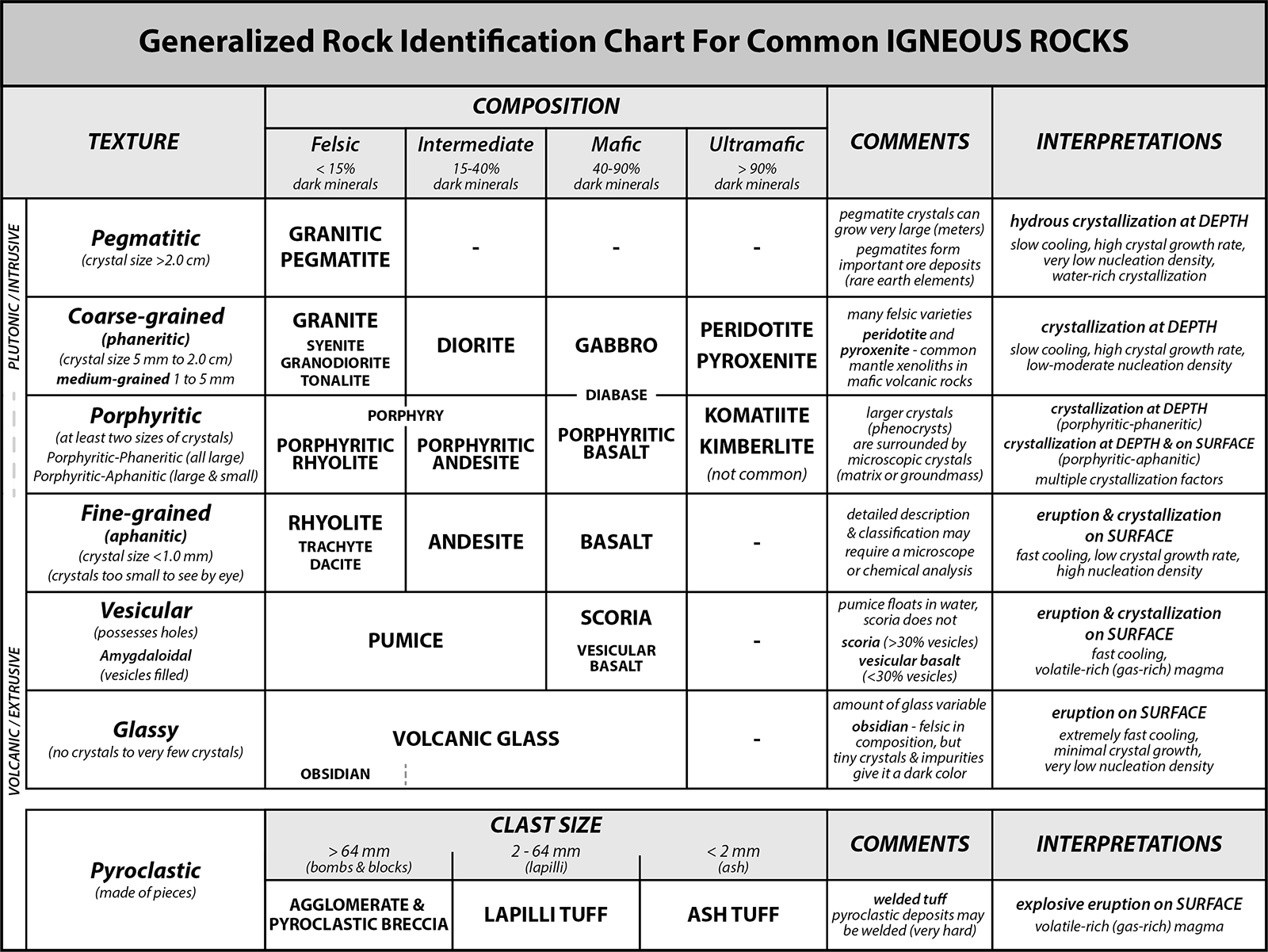Part B
Igneous Rocks
Igneous rocks are part of a group of rocks that form from molten liquid rock or magma. When magma cools and solidifies on the surface, the resulting rock is called volcanic (or extrusive) rock. When the magma crystallizes beneath the surface, the rock that forms is called plutonic (or intrusive) rock.
|
Figure 4-5. Igneous rocks include plutonic (intrusive) and volcanic (extrusive) varieties. A mafic dike (plutonic) at Hance Rapid on the Colorado River (left) and the Sunset Crater cinder cone (volcanic) northeast of Flagstaff, AZ (right). |
|
Magma originates from shallow depths (a few kilometers) to very deep (below 100 km) and since it is typically more bouyant than the surrounding rock, it rises toward the surface. Commonly, the ascent stops before reaching the surface and the magma crystallizes to form a plutonic rock in subterranean magma chambers of various shapes that are termed plutons or intrusions. Plutons have a wide range of size and shape, from relatively thin and sheet-like dikes and sills to larger stocks and batholiths (see Figure 4-5). Since magma is insulated by the surrounding wall rock, it loses its heat rather slowly. Depending on the composition of the magma, certain minerals will start to form (crystallize) at a few starting points (called nucleation points) and slowly grow into larger, interlocking crystals that are big enough to see without a microscope. Each type of mineral will crystallize over a range of temperatures, with the first crystals forming at higher tempertures, followed by others at progressively lower temperatures until all the liguid magma (sometimes called melt) is gone. All this happens deep within the Earth, but we know what happens from experimental laboratory studies.
Volcanic rocks, like their plutonic relatives, are igneous rocks that originally form from molten liquid rock or magma. When magma cools and solidifies on the surface, the resulting rock is called volcanic (or extrusive). Magmas originate from shallow crustal levels (a few kilometers) to deep within the mantle (100 kilometers or more). These magmas are well insulated by the surrounding wall rock, so lose their heat rather slowly where they may crystallize to form a plutonic rock. Due to their positive buouyancy, they may also keep rising toward the surface through conduits, pipes, or fissures, occasionally pausing along the way. Some crystallization may occur during the ascent, producing crystals that are big enough to see without a microscope. Magma erupts onto the surface (and is called lava) with many different and distinct styles, producing an assortment of volcanic rock types and structures (see Figure 4-5). Depending on various factors (like magma composition, the presence of gas or water in the magma, etc.), magmas erupt quietly as lava flows or violently and are blown into pieces. As with plutoninc rocks, certain minerals may start to form (crystallize) as the magma cools. Each type of mineral crystallizes over a range of temperatures, with the first crystals forming at higher tempertures, followed by others at progressively lower temperatures until all the liguid magma (sometimes called melt) is gone. The difference is the rate of crystallization on the surface is much faster, so the resulting crystals are much smaller. Sometimes the lavas cool so fast that they form volcanic glass (with no crystals) or erupt so violently that they are blown into ash-sized particles. All this happens on/near the surface of the Earth, and we observe many volcanic processes first-hand. Volcanic rocks and structures can that tell us about volcanic eruptions of the past.
Compositions of Igneous Rocks
The identification procedure for igneous rocks involves describing the types and sizes of mineral crystals. Since plutonic rocks are generally coarse grained (they have large crystals visible to the naked eye), we have only to identify the minerals and their relative abundances in the rock (see Figure 4-6). In volcanic rocks, the individual mineral crystals are commonly too small to identify, so the mineralogy (and thus, composition) is inferred from the color of the rock (although color is not always representative of composition) (see Figure 4-7). Chemical analysis and the determination of the abundances of certain elements (like Si, Fe, Mg, etc.) can be extremely helpful, not only in classifying these rocks, but in describing the nature and origin of these rocks. The main igneous compositions include felsic, intermediate, mafic, and ultramafic.
|
Figure 4-6. Plutonic rock compositions. There are four basic plutonic compositions: felsic (light-colored; <15% dark minerals), intermediate (15-40% dark minerals), mafic (dark-colored; 40-90% dark minerals), and ultramafic (>90% dark minerals where the green Fe- and Mg-rich mineral olivine counts as a "dark" mineral). |
|
|
|
Figure 4-7. Volcanic rock compositions. There are three basic volcanic compositions (ultramafic volcanics are very rare): felsic (light-colored), intermediate (more gray), and mafic (dark-colored). |
> Generally light-colored; <15% dark-colored minerals.
> Mineralogy - Light-colored minerals include quartz (gray to clear), alkali feldspar (peach-colored to pale red), and plagioclase feldspar (white to gray), whereas the dark-colored minerals are mostly biotite (black flakes).
> Geochemistry - high SiO2 (>63 wt%), Al2O3, Na2O, K2O, etc., and low MgO, FeO, and CaO.
> Typically form from melting continental crust.
> High viscosity lava ("thick & sticky").
> Crystallizes at low temperatures (650-700ºC).
> Plutonic rock examples - granite, granodiorite, tonalite, syenite, quartz monzonite, alkali feldspar granite.
> Volcanic rock examples - rhyolite, dacite.
> Typically gray in color if fine-grained or light and dark ("salt and pepper") if coarse-grained; 15-40% dark-colored minerals.
> Mineralogy - Light-colored minerals include plagioclase feldspar with lesser quartz, whereas the dark-colored minerals are mostly hornblende (black masses or needles) and biotite (black flakes).
> Geochemistry - moderate SiO2 (52-63 wt%).
> Commonly forms from hydrous (water-rich) crustal melting, magma mixing, etc.
> Typically involved in explosive, pyroclastic eruptions.
> Plutonic rock examples - diorite, quartz diorite.
> Volcanic rock examples - andesite, basaltic andesite.
> Generally dark in color; 40-90% dark-colored minerals.
> Mineralogy - Dark-colored minerals mostly include pyroxene (dark green to black) and olivine (green), whereas the light-colored minerals are mostly plagioclase feldspar (white to gray).
> Geochemistry - low SiO2 (45-52 wt%), Al2O3, Na2O, K2O, etc., and high MgO, FeO, and CaO.
> Typically forms from melting ultramafic mantle.
> Forms low viscosity lava (thin & fluid).
> Crystallizes at relatively high temperatures (1000-1200ºC).
> Typically involved in passive, lava-rich eruptions.
> Plutonic rock examples - gabbro, diabase (dolerite).
> Volcanic rock examples - basalt.
> Very dark in color (black to green); >90% dark-colored minerals.
> Mineralogy - Dark-colored minerals almost exclusively pyroxene (dark green to black) and olivine (green).
> Geochemistry - Very low SiO2 (<45 wt%) and very high MgO, FeO, and CaO.
> Plutonic rock examples - peridotite, pyroxenite.
> Volcanic rock examples - komatiite.
![]()
![]()
Textures of Igneous Rocks
The texture of an igneous rock reflects its volcanic (extrusive) or plutonic (intrusive) origin and refers to the size, shape, and orientation of the crystals, or some other visible feature in the rock (see Figure 4-8). The texture of an igneous rock reflects its volcanic (extrusive) or plutonic (intrusive) origin. In general, cooling rate and/or depth of crystallization can be inferred from the size and arrangement of mineral crystals (texture) in a rock.
In plutonic rocks, slow cooling and crystallization beneath the Earth's surface yields only a handful of textures, all composed of mineral crystals large enough to see without a microscope. Plutonic rocks mostly have medium-grained (1-5 mm) to coarse-grained (5 mm to 3 cm) textures or larger. Alternatively, porphyritic textures are composed of crystals of more than one size, with larger crystals (phenocrysts) surrounded by smaller crystals (collectively referred to as groundmass).
Volcanic rocks have several different types of textures that result from a magma's cooling rate, eruption style, and/or gas content. Fine-grained textures (crystals <1 mm) result from rapid cooling. Glassy textures are formed so quickly that few, if any, crystals grow at all. Vesicular textures record the presence of gas in the lava, and pyroclastic textures represent explosive eruptions where the lava has been blown into fragments
|
Figure 4-8. Igneous rocks have several different, easy-to-recognize textures. Clockwise from upper left: coarse-grained (granite), fine-grained (basalt), porphyritic (andesite), glassy (obsidian), pyroclastic (tuff), and vesicular (pumice). |
||
> An equigranular texture (crystals have relatively the same size) where the majority of the crystals can be seen without a microscope (phaneritic means "to see").
> Average crystals are 5 mm to 2 cm in diameter. Medium-grained textures have crystals from 1 mm to 5 mm in diameter.
> Forms as magma cools slowly at depth.
> Plutonic rock examples - granite, diorite, gabbro, pyroxenite, and peridotite.
> An inequigranular texture where crystals have different sizes. In plutonic rocks, porphyritic-phaneritic textures include phenocrysts (larger crystals) and relatively large groundmass crystals that can be identified without a microscope. In volcanic rocks, porphyritic-aphanitic textures include a mixture phenocrysts surrounded by much smaller groundmass crystals. The abundance of phenocrysts can vary, but is typically <25% of the rock. Groundmass crystals are typically <1 mm in diameter and hard to see without magnification.
> Forms as magma crystallizes with at least two stages of cooling: one slower and at depth (forming the phenocrysts), the other faster and less deep or on the surface (forming the groundmass).
> A porphyritic rock with abundant, large phenocrysts may be referred to as porphyry (e.g., feldspar porphyry).
> The word porphyritic can be used as a modifier in the rock name (for example, basalt with olivine phenocrysts is termed porphyritic basalt).
> Plutonic rock examples - porphyritic granite.
> Volcanic rock examples - porhyritic basalt, porhyritic andesite, porhyritic rhyolite, feldspar porphyry.
> Mostly crystals <1 mm in diameter (hard to see without magnification). Larger crystals (phenocrysts) may be present, but are minor in abundance.
> Form as lava cools and crystallizes rapidly on the Earth's surface.
> Volcanic rock examples - basalt, basaltic andesite, andesite, dacite, rhyolite.
> Crystals are few or absent.
> Some surfaces display conchoidal fracture that resemble concentric ripples.
> Forms as magma cools extremely fast, with little or no time for crystal formation.
> Volcanic rock examples - volcanic glass, obsidian.
> A large amount (>5% to >30%) of void spaces (vesicles) that may be open or filled with secondary minerals.
> Vesicular basalt has 5-30% vesicles, scoria has >30% vesicles.
> Vesicles form as a gas-rich magma erupts and cools so quickly that the lava solidifies around the gas bubbles.
> Volcanic rock examples - scoria, pumice.
> Composed of fragments of various types (glass, crystals, or rock) and sizes ranging from very small (ash; <2 mm diameter) to large (cinder, bombs, and blocks and bombs; >64 mm diameter).
> Form during explosive volcanic eruptions.
> Volcanic rock examples - ash tuff, lapilli tuff, pyroclastic breccia.
![]()
![]()
![]()
![]()
![]()
Common Igneous Rocks
Plutonic (Intrusive)
> A typically coarse-grained, light-colored rock that is felsic in composition (<15% dark minerals).
> Mineralogy - Composed primarily of the minerals quartz (gray and glassy), alkali feldspar (peach-colored to white), and plagioclase feldspar (white to light gray), with minor amounts (<15%) of dark-colored biotite.
> Leucocratic granite contains a very low amount of dark minerals. Granitic pegmatite is very coarse-grained rock found in dikes and is commonly rich in quartz, feldspar, and trace elements. Aplitic granite (aplite) is a fine-grained variant also found in dikes.
> Typically originates from melting of continental crust.
> Forms many types of intrusive igneous bodies (plutons), including large batholiths.
> Intrusive equivalent of rhyolite.
> Arizona examples - Camelback Granite (Phoenix), Komatke Granite (South Mountain), Dells Granite (Prescott).
> A coarse-grained, light- and dark-colored rock that is intermediate in composition (15-40% dark minerals).
> Mineralogy - Largely composed of amphibole (black) and plagioclase feldspar (white to gray) and has a higher abundance (15-40%) of dark-colored minerals than granite. The texture of diorite is commonly referred to as "salt and pepper" because of its black and white appearance.
> Commonly originates from subduction-related partial melting of oceanic and/or continental crust. May be associated with both felsic and mafic plutons.
> Intrusive equivalent of andesite.
> Arizona examples - Ruby pluton (Grand Canyon), Bland Quartz Diorite (central Arizona).
> A coarse-grained, dark-colored rock that is mafic in composition (40-90% dark minerals).
> Mineralogy - Primarily composed of large amounts (40-90%) of pyroxene (black or very dark green) and plagioclase feldspar (gray), with lesser amounts of olivine (green and glassy).
> Derived from partial melting of the mantle. Forms much the oceanic crust.
> Intrusive equivalent of basalt.
> Arizona examples - Gibson Creek Complex (near Payson), and many small, unnamed bodies across Arizona.
> A coarse-grained, dark-colored rock that is ultramafic in composition (>90% dark minerals).
> Mineralogy - Composed of large amounts (>90%) of olivine (>40%) and pyroxene.
> Forms much of the Earth's mantle and can partially melt to yield mafic magmas.
> Arizona examples - Nodules of peridotite can be found in some basaltic lava flows around Arizona, including in the San Bernardino Valley and near San Carlos.
Volcanic (Extrusive)
> A fine-grained to porphyritic, light-colored rock that is felsic in composition.
> Mineralogy - Typically contains quartz, alkali feldspar, and plagioclase feldspar, with minor amounts of biotite.
> Dacite is compositionally between andesite and rhyolite, and has more quartz than andesite and more plagioclase feldspar than rhyolite.
> Geochemistry - >63 wt% SiO2.
> Originates from the melting of continental crust.
> Highly viscous lavas form short, thick flows and steep-sided lava domes . May include explosive eruptions.
> Extrusive equivalent of granite. Dacite is the extrusive equivalent of granodiorite.
> Arizona examples - Superstition Mountains (near Phoenix); Chiricahua Mountains (southeastern Arizona), Kofa Mountains (southwestern Arizona); San Francisco volcanic field (near Flagstaff).
> A fine-grained to porphyritic, light- to gray-colored rock that is intermediate in composition.
> Mineralogy - Typically contains plagioclase and amphibole phenocrysts.
> Geochemistry - 52-63 wt% SiO2.
> Basaltic andesite is compositionally between basalt and andesite and has higher SiO2 (52-57 wt%) than basalt.
> Forms from hydrous melting of oceanic and/or continental crust, magma mixing, etc.
> Fairly viscous lavas that can be water-rich, helping to produce explosive eruptions of ash and lava that form steep-sided composite volcanoes (stratovolcanoes).
> Extrusive equivalent of diorite.
> Arizona examples - Tempe Butte (on the ASU campus); San Francisco Mountain (north of Flagstaff).
> A dark-colored rock that is mafic in composition.
> Mineralogy - Commonly contains olivine, pyroxene, and plagioclase feldspar.
> Geochemistry - 45-52 wt% SiO2.
> Basalt having 5-30% vesicles is called vesicular basalt, whereas basalt with >30% vesicles is termed scoria.
> Originates from the partial melting of ultramafic mantle rocks.
> Highly fluid lavas that erupt in a passive manner, forming lava flows, shield volcanoes , and cinder cones.
> Extrusive equivalent of gabbro.
> Arizona examples - San Francisco volcanic field (northern Arizona), Uinkaret volcanic field (NW Arizona); Perry Mesa (along I-17 in central Arizona), Sentinel volcanic field (along I-8 in SW Arizona).
Volcanic Glass & Obsidian ![]()
> Dark-colored (either black or reddish brown) volcanic glass.
> Forms when lava is quenched (very suddenly cooled) and there is no time for crystals to form.
> Volcanic glass can have any composition. Obsidian is felsic, with its dark color from elemental impurities & lack of microscopic bubbles. Alters over time (changes color, cracks).
> Arizona examples - Locally exposed in felsic volcanic fields; Picketpost Mountain (near Superior).
> A dark-colored (reddish to black), fine-grained to glassy rock with a vesicular texture (>30% vesicles).
> Forms from gas-rich mafic lava. As magma rises to the surface, gas bubbles grow and try to escape as the magma/lava solidifies.
> Unlike pumice, scoria will typically sink in water because of its higher density.
> Arizona examples - Scoria is common in mafic volcanic fields where cinder cones are abundant (San Francisco volcanic field).
> A light-colored, frothy, volcanic glass that is extremely vesicular.
> Forms from gas-rich felsic to intermediate lava. As magma rises to the surface, gas bubbles grow and try to escape as the magma/lava solidifies.
> Pumice can actually float in water due to its low average density (from all the air pockets within it).
> Arizona examples - Pumice deposits are also locally exposed in the northern San Francisco volcanic field.
Pyroclastic Rocks (Agglomerate, Pyroclastic Breccia, Lapilli Tuff, Ash Tuff) ![]()
> Pyroclastic rocks are made of pieces where the size of the pieces can vary from ash-sized (very small) to large blocks and bombs (meters in diameter).
> Tuff is a word generally used to describe fine-grained airfall material (tephra).
> Ash tuff is a fine-grained pyroclastic rock where the average size of pyroclastic particles is ash-sized (<2 mm). Ash tuff may be massive or well-bedded, and can be transformed by high-temperatures after deposition into more resistant welded tuff.
> Lapilli tuff is a pyroclastic rock where the average size of pyroclastic particles is gravel-sized (2 mm to 64 mm).
> Pyroclastic breccia is a coarse-grained pyroclastic rock where large angular clasts are boulder-sized or bigger (>64 mm).
> Agglomerate is formed from molten to partially molten airfall material (spatter, volcanic bombs) that typically welds together along the rims of volcanic vents.
> Pieces can include solidified lava, as well as rock fragments accidentally caught in the eruption.
> Pyroclastic rocks are formed in a wide range of volcanic eruptions. The smaller the fragments, the more violent the eruption.
> Arizona examples - Peach Springs Tuff (northern Arizona); felsic volcanic fields (Superstition, Chiricahua, etc.).
Igneous Rock Identification
The classification for plutonic and volcanic rocks is straightforward: identify the texture and composition. Volcanic textures are fairly distinctive, and general color or mineral phenocrysts are used to estimate composition. All plutonic rocks have big crystals, so all you really need to do with them is estimate the amount of dark-colored minerals in them. Much of this information is shown in the igneous rock identification chart below (Figure 4-9).
|
Figure 4-9. A rock identification chart for common igneous rocks. |
* IMPORTANT *
Using the PDF link above, print a hard-copy version of this chart for use in this lab and the lab quiz.
Examine the texture and composition of each sample to answer Quiz Me! questions B18 throug B25. Refer to the igneous rock identification chart and the rock descriptions.
![]()
![]()
![]()
![]()
![]()
![]()
![]()
![]()
